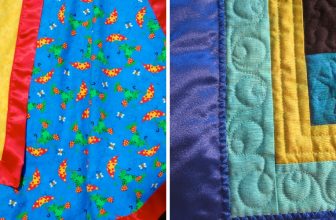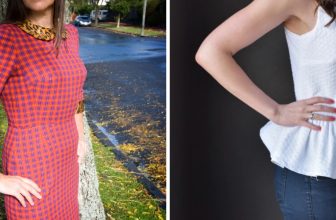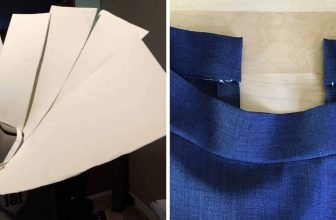How to Sew a Cosmetic Bag
Sewing is an essential skill that can help you create various items, such as clothing, home decor, and accessories. One of the most convenient things to sew is a cosmetic bag. It’s a versatile item that can be used for storing makeup or other small items like jewelry and toiletries.
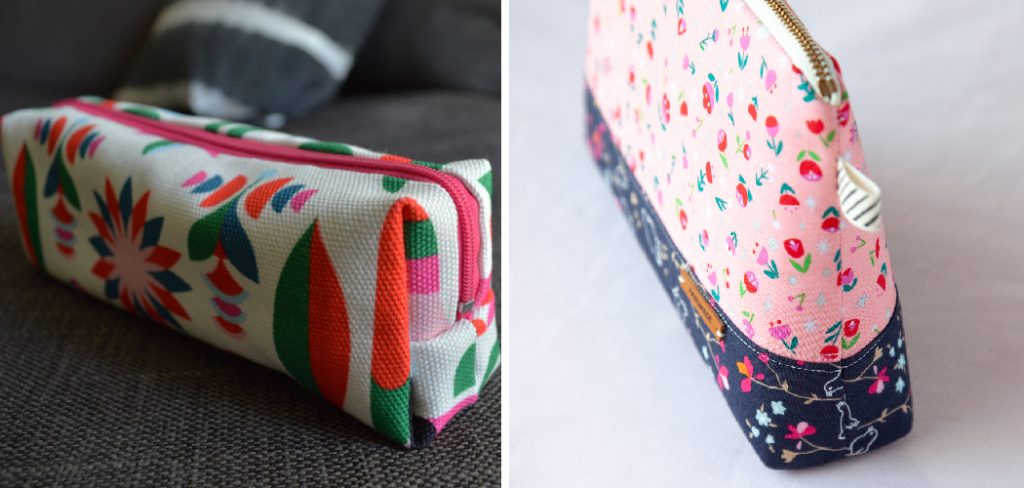
The main advantage of knowing to sew a cosmetic bag is that you can create a customized and unique bag that suits your personal style and needs. This allows you to stand out from the crowd and have a one-of-a-kind accessory. In this blog post, You will learn in detail how to sew a cosmetic bag.
Step-by-step Instructions for How to Sew a Cosmetic Bag
Step 1: Inspect Fabric and Gather Materials

Before beginning the steps for sewing a cosmetic bag, it is important to inspect your chosen fabric for any defects or flaws. This will ensure that your finished bag looks professional and visually appealing. Additionally, make sure you have all the necessary materials on hand such as thread, scissors, pins, and a sewing machine.
Step 2: Measure and Cut Fabric
Measure and cut your chosen fabric to the desired size for your cosmetic bag. It is recommended to add an extra half inch on each side for seam allowance. This will give you room to work with while sewing and also prevent the fabric from fraying.
Fold your fabric in half, with the right sides facing inwards. Then, pin the edges together to secure the fabric in place. This will create a seam that you can sew along to form the sides of your cosmetic bag.
Step 3: Sew Along Pinned Edges
Using your sewing machine, carefully sew along the pinned edges with a straight stitch. Make sure to backstitch at both ends to reinforce the seams. Once you have sewn the sides of your cosmetic bag, trim any excess fabric and finish the edges with a zigzag stitch. This will prevent fraying and give your bag a clean and professional look.
Step 4: Create Lining for Bag

Using the same process as steps 2-5, cut and sew together a lining for your cosmetic bag. This will provide extra support and protection for the items stored inside. With both the main fabric and lining pieces right side out, insert the lining into the main fabric so that the wrong sides are facing each other. Pin around the top edge of the bag and sew together with a straight stitch.
Step 5: Add Zipper
To create a closure for your cosmetic bag, you will need to attach a zipper. Pin the zipper along the top edge of the bag and sew in place with a straight stitch. Make sure to backstitch at both ends for durability. If desired, you can add a handle to your cosmetic bag for easy carrying. Cut a strip of fabric to the desired length and width and sew together with right sides facing. Turn inside out and attach to the sides of the bag with a zigzag stitch.
Step 6: Finish Off
To complete your cosmetic bag, trim any excess threads and give it a final press with an iron. You can also add any embellishments or decorative elements at this time to personalize your bag.
By following these easy steps, you can create a beautiful and functional cosmetic bag that is perfect for storing all your makeup and beauty essentials. This project is great for beginner sewers and can be customized with different fabric choices and designs. Get creative and make multiple bags for yourself or as gifts to friends and family.
Safety Tips for How to Sew a Cosmetic Bag
- Always use sharp needles and scissors. Sharp tools make sewing easier and safer, as they require less force to cut through fabric. Dull tools can lead to accidents or injuries.
- Take breaks every 20-30 minutes. Sewing for long periods of time can cause fatigue, leading to mistakes that can be dangerous. Taking short breaks allows you to rest your eyes, hands, and mind.
- Use the right seam allowance. Sewing with a smaller or larger seam allowance than recommended can affect the fit of your cosmetic bag and make it less secure. Double-check your pattern to ensure you are using the correct seam allowance.
- Keep pins and needles organized. It’s important to keep track of your pins and needles to avoid accidentally stepping on them or losing them in the fabric. Use a pin cushion or magnetic holder to keep them in one place.
- Keep your work area clean and organized. A cluttered workspace can make it difficult to find tools and materials, leading to accidents or injuries. Take a few minutes before starting a project to tidy up your workspace.
- Use proper lighting. Sewing with poor lighting can strain your eyes and lead to mistakes. Make sure you have adequate lighting in your sewing area, whether it’s natural or artificial.
- Be aware of your surroundings. When using a sewing machine, make sure there are no loose fabric or threads near the needle that can get caught. Also, be mindful of others around you who may be passing by or helping with the project.
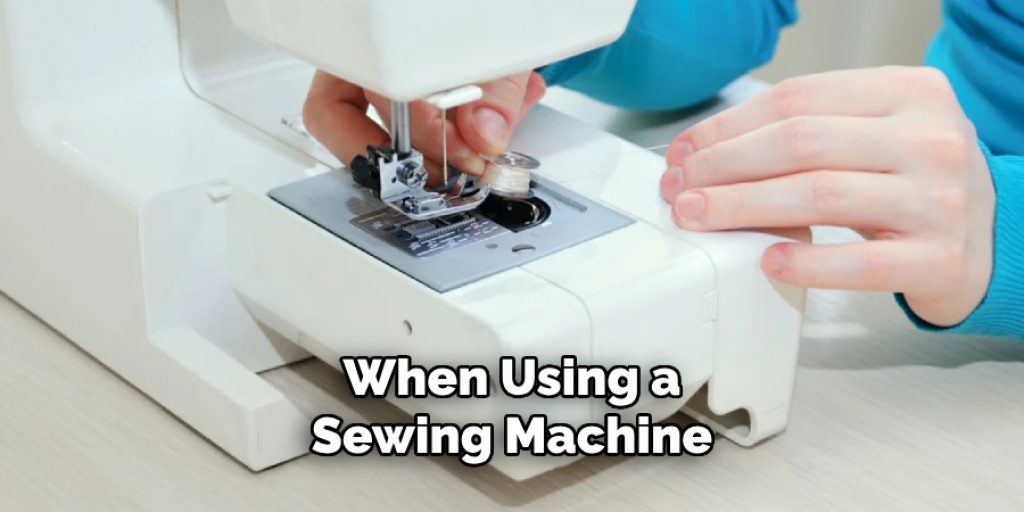
In addition to these safety tips, it’s important to always read and follow the instructions on your sewing machine and tools. Each can have their own unique safety precautions that should be taken into consideration.
How Can You Properly Clean and Care for Your Finished Cosmetic Bag?
Now that you have finished creating your own cosmetic bag, it is important to know how to properly clean and care for it. This will help ensure that your bag stays in good condition and continues to look great even after multiple uses.
Cleaning Your Cosmetic Bag:
The first step in cleaning your cosmetic bag is to empty out all of its contents. Make sure to remove any products or brushes that may have spilled or left residue inside the bag. Then, turn the bag inside out and shake off any loose particles or debris.
Next, check the material of your cosmetic bag and refer to its care instructions. Some bags may be machine washable while others may need to be hand washed. If you are unsure, it is always best to hand wash your bag to avoid any potential damage.
To hand wash your cosmetic bag, fill a sink or bucket with warm water and add a small amount of mild detergent. Dip the bag into the water and gently scrub any stains or dirt spots using a soft cloth or sponge. Be careful not to use too much force as this can cause the material to tear.
After washing, rinse the bag thoroughly with clean water and gently squeeze out any excess water. To dry, lay the bag flat on a towel or hang it up to air dry. Do not use a clothes dryer as this can damage the material.
Caring for Your Cosmetic Bag:
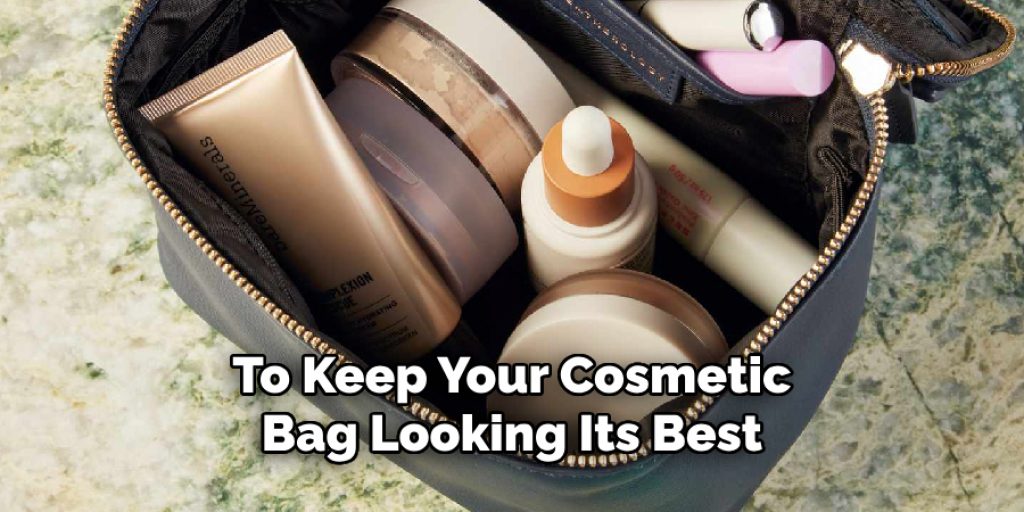
To keep your cosmetic bag looking its best, there are a few things you can do to care for it. First, always store your bag in a cool and dry place when not in use. Avoid storing it in direct sunlight or near sources of heat as this can cause the material to fade or warp.
If you notice any stains on your bag, spot clean them immediately using a mild detergent and warm water. Do not let the stain set as it will be harder to remove later on.
It is also important to regularly check the zippers and seams of your bag for any signs of wear and tear. If you notice any loose threads or broken zippers, it is best to get them repaired as soon as possible to prevent further damage.
Lastly, avoid overstuffing your bag with too many products as this can cause the material to stretch and lose its shape. Be mindful of how much you put in your bag and try to keep it organized to prevent any unnecessary strain on the material.
By following these simple cleaning and caring tips, you can ensure that your finished cosmetic bag stays in great condition for a long time. This will not only save you money from having to constantly buy new bags, but it will also help reduce waste and be more environmentally friendly.
What Are Some Common Mistakes to Avoid While Sewing a Cosmetic Bag?

Sewing a cosmetic bag may seem like an easy task, but there are some common mistakes that can happen if you’re not careful. Here are a few things to keep in mind while sewing your own cosmetic bag:
- Not Using the Right Materials: The fabric and thread you use can make a big difference in the durability and functionality of your cosmetic bag. Make sure to choose a durable fabric and thread that can withstand the weight of your cosmetics and accessories.
- Not Measuring Accurately: It’s important to measure all of your materials accurately before cutting and sewing. Even a small mistake in measurement can result in an ill-fitting or lopsided bag.
- Not Using the Right Needle: When sewing with different types of fabrics, it’s important to use the appropriate needle. For example, a heavy-duty needle may be needed for thicker fabrics, while a finer needle is better suited for delicate fabrics.
- Not Pinning the Fabric: Pinning the fabric in place before sewing can help ensure that everything stays in place and lines up properly. This is especially important when working with multiple layers of fabric.
- Rushing Through the Project: Sewing takes time and patience, so it’s important to take your time and not rush through the steps. This will help you avoid mistakes and create a better end result.
By being mindful of these common mistakes and taking your time while sewing, you can ensure that your cosmetic bag turns out just the way you want it.
Are There Any Environmentally Friendly Options for Materials to Use When Sewing a Cosmetic Bag?

When it comes to sewing a cosmetic bag, there are many options for materials that can be used. However, as we strive towards a more environmentally friendly lifestyle, it is important to consider the impact our choices have on the environment. Fortunately, there are several eco-friendly options available for sewing a cosmetic bag that not only reduce waste but also offer durability and practicality. Here are a few options to consider:
1. Organic Cotton
Organic cotton is grown without the use of harmful chemicals or pesticides, making it a great choice for an eco-friendly cosmetic bag. It is soft, durable and readily available in various colors and patterns.
2. Recycled Fabrics
Another sustainable option for sewing a cosmetic bag is using recycled fabrics. This can include repurposed fabrics from old clothing, linens or even plastic bottles that have been turned into fabric. Not only does it reduce waste, but it also adds a unique touch to your cosmetic bag.
3. Linen
Linen is a natural and biodegradable fabric that is perfect for sewing a cosmetic bag. It is strong, lightweight and has anti-bacterial properties, making it a practical choice for storing makeup and toiletries.
4. Cork Fabric

Cork fabric is made from the bark of cork trees, making it a sustainable option for sewing a cosmetic bag. It is water-resistant, durable and lightweight, making it an excellent alternative to leather.
Apart from choosing eco-friendly materials, there are other ways you can make your cosmetic bag more environmentally friendly.
What Are Some Creative Ways to Repurpose Old Fabric or Clothing When Making a Cosmetic Bag?
- Turn old t-shirts or tank tops into a drawstring makeup bag by stitching the bottom shut and adding a drawstring closure.
- Transform an old pair of jeans into a denim cosmetic bag by cutting out the desired size and sewing the edges together.
- Use scraps of fabric to create a patchwork design for a unique and colorful cosmetic bag.
- Repurpose an old scarf or bandana as a lining for a fabric cosmetic bag.
- Create a no-sew cosmetic bag by using hot glue or fabric glue to attach pieces of fabric together.
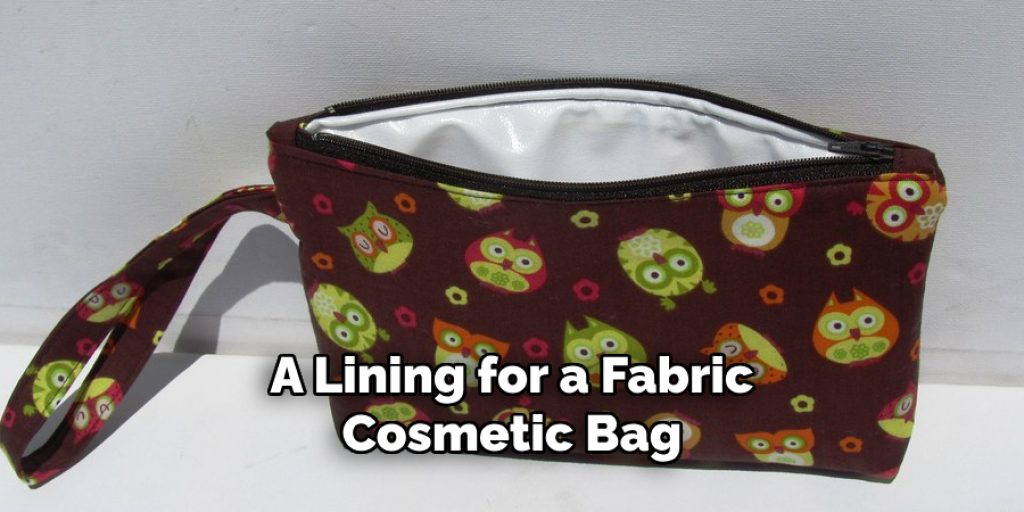
There are endless possibilities when it comes to repurposing old fabric or clothing into a cosmetic bag. Not only is this environmentally friendly, but it also allows you to get creative and make one-of-a-kind pieces.
Are There Any Advanced Techniques or Designs for Making a More Intricate and Unique Cosmetic Bag?
Yes, there are many advanced techniques and designs that can be used to create a more intricate and unique cosmetic bag. Some of these techniques include:
- Embroidery: Embroidery is a popular technique used to add intricate designs and patterns onto fabric. This technique involves using colored threads to stitch designs onto the fabric surface. With embroidery, you can add personalized details, such as names or initials, onto your cosmetic bag.
- Applique: Applique is a process of attaching fabric or decorative pieces onto a base fabric to create a design. This technique is often used to add layers and texture to the surface of a cosmetic bag. It allows for endless possibilities in terms of designs and patterns.
- Beading: Adding beads onto a cosmetic bag can give it an elegant and luxurious touch. Beads come in various shapes, sizes, and materials, making them perfect for creating intricate designs and patterns on your cosmetic bag.
- Patchwork: Patchwork is a technique that involves sewing together small pieces of fabric to create a larger design. This technique allows for endless creativity as you can mix and match different fabrics and patterns to create a unique and eye-catching cosmetic bag.
- Quilting: Quilting is a popular technique used to add texture and dimension to fabric. It involves stitching together layers of fabric with a layer of padding in between. This technique can be used to create intricate designs on your cosmetic bag, such as geometric patterns or floral motifs.
- Laser-cutting: With advancements in technology, laser-cutting has become a popular technique for creating intricate and precise designs on fabric. This method uses a laser to cut out intricate patterns and shapes onto the fabric surface, giving your cosmetic bag a unique and modern look.
- Painting: If you are artistically inclined, you can use fabric paint or markers to create one-of-a-kind designs on your cosmetic bag. You can use stencils or freehand painting to add personal touches and unique details onto your bag.
- Mixed Media: Using a combination of different techniques, such as embroidery, applique, and painting, can result in a truly unique and intricate design for your cosmetic bag. Don’t be afraid to experiment with different techniques to create a one-of-a-kind piece.
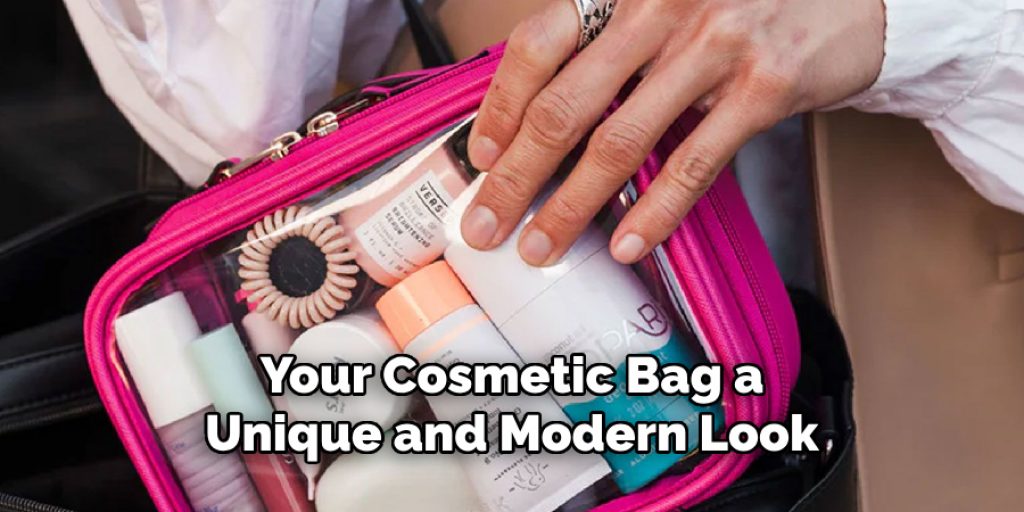
In addition to these advanced techniques, you can also incorporate unique materials into your cosmetic bag design, such as leather, lace, or sequins. Experimenting with different fabrics and textures can add an extra level of complexity and uniqueness to your cosmetic bag.
Conclusion
In conclusion, sewing a cosmetic bag is an enjoyable and rewarding DIY project that anyone can do. It allows for creativity and personalization, making it a practical and stylish accessory to have. Not only does sewing your own cosmetic bag save money in the long run, but it also reduces waste by using fabric scraps or repurposing old clothing. It’s a sustainable way to add something new to your collection without contributing to the fast fashion industry.
Furthermore, sewing can also be a relaxing and therapeutic activity. The repetitive motions of cutting, pinning, and stitching can help reduce stress and anxiety. It’s a great way to unwind after a long day or during times of high pressure. I hope reading this post has helped you learn how to sew a cosmetic bag. Make sure the safety precautions are carried out in the order listed.

